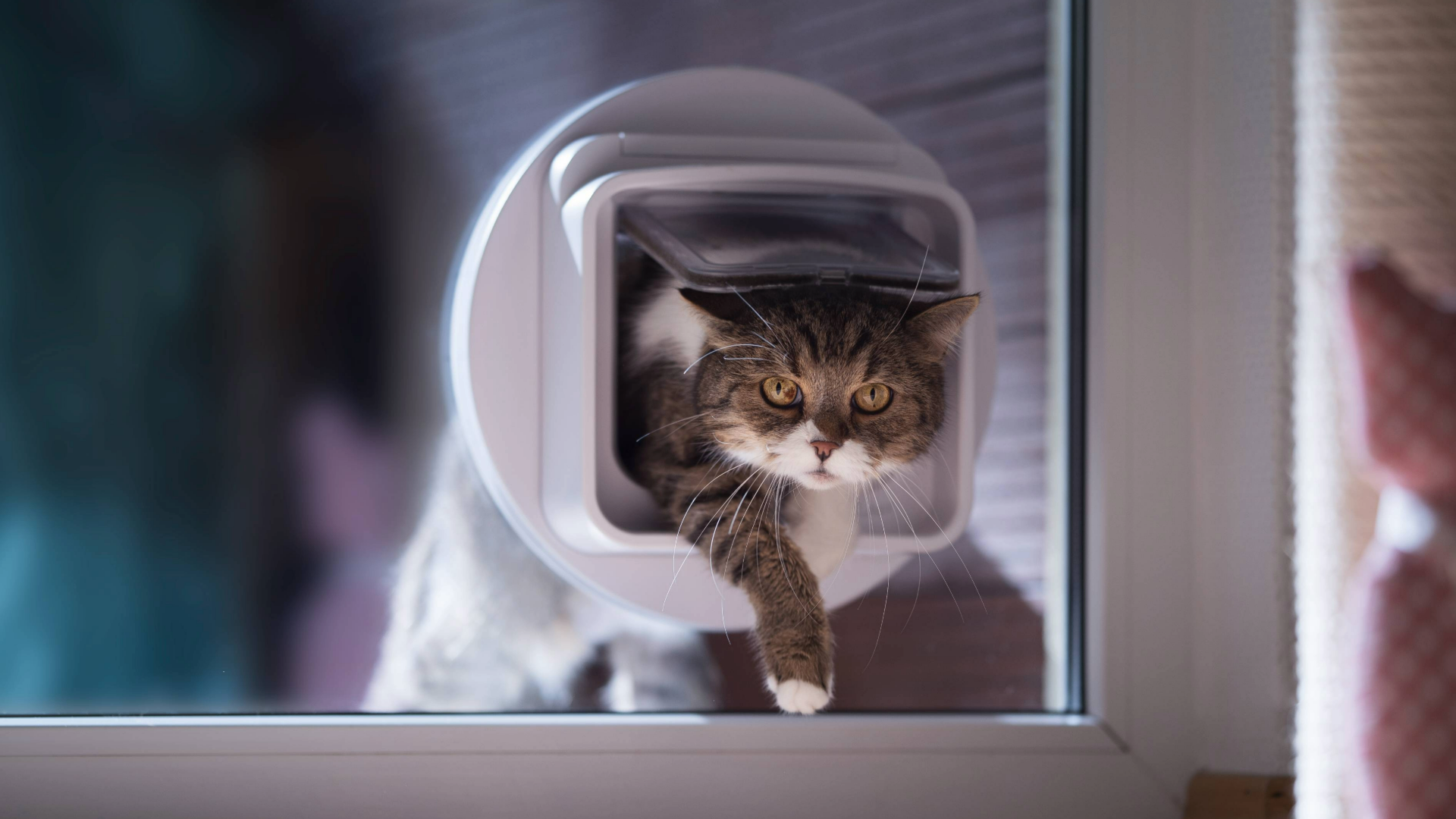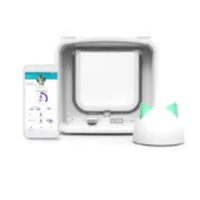How do microchip cat flaps work? Everything you need to know (including whether they’re worth it)
If you’re wondering, ‘How do microchip cat flaps work?’, we’re here to help!

How do microchip cat flaps work? While regular pet doors let any animal walk into your home, the best microchip cat flaps restrict access to selected pets only.
When a cat is microchipped, a tiny chip containing a unique number is implanted under their skin (usually between their shoulder blades). When a vet scans it, information about the pet and their owner can be displayed from a database, helping to reunite them if they ever go missing.
Microchip cat flaps use Radio Frequency Identification (RFID) technology to scan and read these chips, remaining locked until they detect registered chip numbers. This can give you peace of mind that only your cats can get through. For felines who aren’t microchipped, most brands sell special I.D. tags that can be clipped onto their collar and registered to the device.
Intruding animals can make your cat feel very stressed, and it can take months to reverse the impact of this negative experience, according to animal behaviorist Amanda Campion. A microchip cat flap will put a stop to this, and some devices even allow you to track your pet’s location, set curfews, and remotely lock or unlock it from your phone! Below, we’ve answered everything you need to know:
How do you set up a microchip cat flap?
One of the first things you need to do is find out if your feline's microchip is compatible with the microchip cat flap you're looking to buy. Manufacturers generally list this so take a look at their website or study the box.
Next, you'll need to pop some batteries into the microchip cat flap. As you may have guessed, the technology needed to scan your cat's microchip requires technology but the good news is that these devices don't need to be hardwired.
When you're ready to program the cat flap, you'll need to make sure your feline friend is close by. You will then be required to set the manual lock so that your moggy can go in and out of the flap unhindered before putting the device into its learn or memory mode. This is usually done by pressing a button.
Get the best advice, tips and top tech for your beloved Pets
By then placing your cat's head through the cat flap (or encouraging your feline friend to do it themselves), the device will scan and save your pet's identifying number. Just don't allow any stranger cats to pop through before your pet otherwise it would remember their number instead!
From this point, the door will close and the device will be in what's usually called the “primary” mode. The flap will only open if your cat tries to pop its head through. It will remain shut for other cats and animals. What's more, it will only open if your cat is actively trying to get in. Approved pets can't just wander by and unlock the flap, allowing any other passing animals to take advantage.
We also have a helpful guide on how to train a cat to use a cat door.
SureFlap Microchip Cat Door Connect with Hub
This is the best microchip cat flap we’ve ever tested — we love how you can control it from an app on your phone! If one of your cats needs to stay indoors until their vet appointment, you can set a curfew to ensure they don’t escape. The app will also notify you of their last location, the time they entered or left the house, and give you stats about their activity levels. If you want to learn more, check out our in-depth and honest Sureflap Connect review.
PetSafe 4-Way Locking Microchip Entry Cat Door
This budget-friendly cat flap can be registered for up to 40 cats and has a draught excluder to keep the cold out. When testing it out, I found the instructions super simple to follow and it was easy to program my cats’ microchips. It doesn’t have as many cool features as the SureFlap Connect, but it’s a brilliant basic option if you don’t want to spend too much money.
Do microchip cat flaps work both ways?
Some microchip cat flaps work both ways but some don't. Simpler microchip cat flaps will be selective about which cats are able to enter your home but they will let any moggy out without checks. This can be desirable, especially if an unwanted animal tailgates your pet and manages to get in because it means they can easily get back out again.
If you have other pets, however, and you're worried they might take advantage of the cat flap and decide to pop outside, you should buy a device that scans both ways.
In any case, you will be able to lock most cat flaps in one of four positions depending on what you're looking to achieve. These include allowing entry and exit or completely locking the device as well as two other useful functions.
You could, for example, allow a cat to enter but not exit which is ideal if you're hoping to take a cat to the vet within the next hour or so or if you'd like to keep the moggy in overnight. You could also allow a cat to leave but not come back inside your home for a short while. This works well if you have a visitor who is allergic to cats or if a friend has brought a dog who may not rub along well with your feline friend.

What is a dual scan cat flap?
But what if you have more than one cat? Well, most cat flaps will allow you to store a large number of unique identifiers – anywhere between 25 and 40 in some cases which is plenty for most of us! But if you do have more than one cat, then it's worth investing in a dual scan cat flap – or DualScan as it is written.
These cat flaps give you an amazing amount of control because it's a technology that not only scans when a cat is exiting as well as entering a property, it also allows you to program the device for individual felines.
Let's say you may want to take one of two cats to the vets. In this case you'd prevent one of them from making a run for it through the cat flap but you'd allow the other feline to come and go at will. Usually, with this technology, a cat that does manage to escape (through an open door perhaps) will be allowed back in again. It's the ultimate technology for multi-cat households.

Is it worth getting a microchip cat flap?
Certainly, microchip cat flaps are better than basic ones. Although a non-powered flap will allow you a modicum of control in the shape of a little piece of plastic that you can use to open and close the device, microchip cat flaps prevent intruders.
You could team them up with one of the best pet cameras to keep a closer eye on your feline's coming and goings. In short, they help your cats to feel safe in their own home and ensure no other animals are stealing their food. Installing and programming them is also quick and easy. The only downside is they are a little more expensive but they are totally worth the cost
Rover Pet People panelist and cat behavior expert Dr. Mikel Delgado says: "Cats are highly territorial, it’s not necessarily due to jealousy but rather an instinct to protect what’s theirs. Imagine how you would feel if a stranger entered your house or yard without your consent -- you would likely be very upset. Your cat, similarly, would not be happy for an unexpected cat to show up in his or her territory."
You might also want to read: How to install a pet door and the best cat door alternatives.

David Crookes has been a journalist for almost 30 years and he has written for a host of magazines, newspapers, websites and books including the World of Animals Annual, BBC Earth, Live Science, The Independent and Tom’s Guide.
Born in England, he lives with two cats but he’s also keenly interested in the differences between the huge number of dog breeds – in fact, you can read many of his breed guides that he’s written in collaboration with vets here on PetsRadar.
With a lifelong passion for technology, too, he’s always on the lookout for useful devices that will allow people to keep their pets happier and healthier, and provide them more time to spend together.
David has a degree from Durham University, as well as postgraduate diploma in journalism from the University of Central Lancashire.


